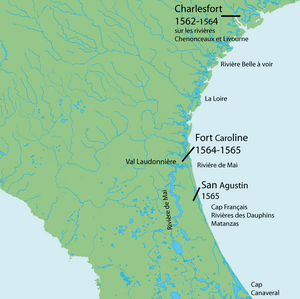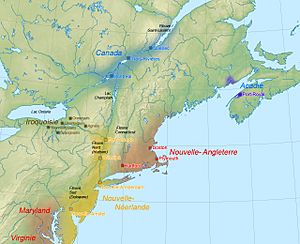French colonization of the Americas facts for kids
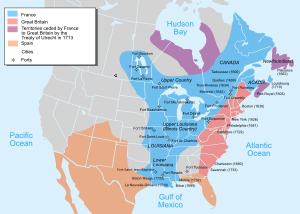
The French colonization of the Americas was when France started building a colonial empire in the Western Hemisphere. This began in the 1500s and continued for centuries. France set up colonies in eastern North America, on several Caribbean islands, and in South America. Most of these colonies were created to get products like fish, sugar, and furs to send back to France.
As they settled in the New World, the French built forts and towns. Many of these places grew into important cities we know today. For example, Quebec and Montreal in Canada; Detroit, Green Bay, St. Louis, Mobile, and New Orleans in the United States. They also founded Port-au-Prince in Haiti, Cayenne in French Guiana, and São Luís in Brazil.
Contents
French Settlements in North America
Early Explorers and First Attempts
The French first came to the New World as explorers. They were looking for a way to the Pacific Ocean and hoping to find riches. In 1524, King Francis I sent Giovanni da Verrazzano to explore the coast between Florida and Newfoundland. Verrazzano named this land "Francesca" and "Nova Gallia," showing France's interest.
In 1534, King Francis I sent Jacques Cartier on his first trip. He explored the coast of Newfoundland and the Saint Lawrence River. Cartier is known for planting a cross on the Gaspé Peninsula, which marked the beginning of New France.
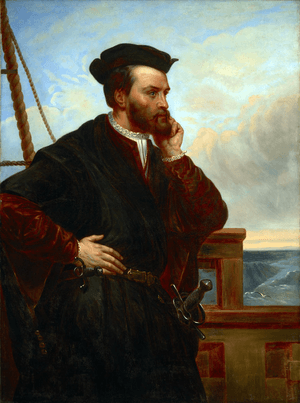
The French tried to build several colonies in North America, but many failed. This was often due to bad weather, diseases like scurvy, or fights with other European powers and Native American groups. For example, Cartier tried to start a settlement at Cap-Rouge in 1541, but it was abandoned a year later. Other early attempts in places like Parris Island, South Carolina (Charlesfort) and Jacksonville, Florida (Fort Caroline) also did not last long.
Building New France
Despite early failures, the French kept trying. In 1604, a short-lived colony was set up on Saint Croix Island, Maine in Acadia, but it moved to Port Royal the next year.
Samuel de Champlain was a very important figure. He founded Quebec in 1608, which became the capital of New France. Champlain also explored the Great Lakes region. Other explorers and founders established more settlements:
- Jean Nicolet founded La Baye des Puants (now Green Bay) in 1634.
- Sieur de Laviolette founded Trois-Rivières in 1634.
- Paul de Chomedey, Sieur de Maisonneuve founded Ville-Marie (now Montreal) in 1642.
- Louis Jolliet and Jacques Marquette founded Sault Sainte Marie (1668) and Saint Ignace (1671). They also explored the Mississippi River.
- By the late 1600s, René-Robert Cavelier, Sieur de La Salle created a network of forts from the Gulf of Mexico to the Great Lakes.
- Antoine de la Mothe Cadillac founded Fort Pontchartrain du Détroit (modern-day Detroit) in 1701.
- Jean-Baptiste Le Moyne de Bienville founded La Nouvelle Orléans (New Orleans) in 1718.
- Pierre Le Moyne d'Iberville founded Baton Rouge in 1719.
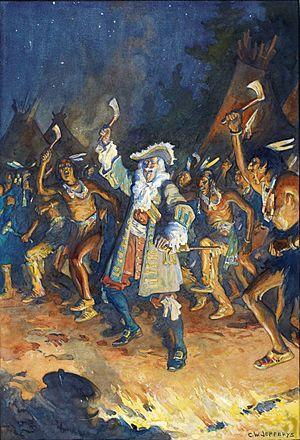
The French were eager to explore, but New France did not have many people. Because there were few French women, many French men married Native American women. This led to the creation of the Métis people. Relations between the French and Native Americans were usually peaceful. The historian Francis Parkman noted that "French civilization embraced and cherished him" (referring to Native Americans).
To help the population grow, Cardinal Richelieu made a rule in 1627. It said that Native Americans who became Catholic were considered "natural Frenchmen." Later, King Louis XIV sent about 800 young women, called the "King's Daughters," to New France to marry settlers. However, the population remained small. By the start of the French and Indian War (1754–1763), the British population in North America was 20 times larger than the French population. France fought several wars in North America against the British and their allies.
French Florida: A Short-Lived Colony
In 1562, King Charles IX sent Jean Ribault and a group of Huguenot (French Protestant) settlers to try and colonize the Atlantic coast. They built a fort called Charlesfort on what is now Parris Island, South Carolina. This group later moved south and founded Fort Caroline in Florida in 1564.
This angered the Spanish, who claimed Florida and were also against the Protestant settlers for religious reasons. In 1565, Pedro Menéndez de Avilés led a group of Spaniards and founded Saint Augustine, south of Fort Caroline. The Spanish attacked Fort Caroline and killed most of its occupants, including Jean Ribault. This ended the French attempt to colonize Florida.
Canada and Acadia: Fur Trade and Wars
The French were first interested in the rich fishing areas off Newfoundland. But by the early 1600s, they became more interested in the fur trade. A fur trading post was set up in Tadoussac in 1600. Samuel de Champlain made his first trip to Canada in 1603 for fur trading. He mapped the St. Lawrence River and wrote about his experiences.
In 1608, Champlain founded Quebec, which became the capital of New France. In Quebec, Champlain made alliances with the Huron and Ottawa peoples. They worked together against their enemies, the Iroquois. French explorers used canoes made from birch bark to travel quickly through the Great Lakes and their rivers.
From 1629 to 1632, the British took control of Quebec and Canada. Champlain was captured. However, the Treaty of Saint-Germain-en-Laye returned the colony to France in 1632. The city of Trois-Rivières was founded in 1634, and Montreal (originally Ville-Marie) was founded in 1642 as a fort against Iroquois attacks.
Despite this growth, the colony developed slowly. Wars with the Iroquois and diseases caused many deaths. In 1663, when King Louis XIV took direct control, New France had only about 2,500 European settlers. To boost the population, King Louis XIV sent the "King's Daughters" to become wives for the settlers. The population grew to 15,000 by 1689.
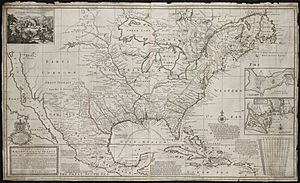
From 1689 to 1713, the French settlers faced almost constant war with the British. These were part of the larger French and Indian Wars. Quebec City successfully defended itself against British attacks in 1690 and 1711. However, after the War of the Spanish Succession, France had to give up some land. The Treaty of Utrecht in 1713 gave Acadia, Newfoundland, and Hudson Bay to Britain.
The population of New France grew, but it was still much smaller than the British colonies to the south. By the mid-1700s, New France had about 60,000 people, while the British colonies had over a million. This put the French at a big disadvantage in military conflicts. A final, decisive war began in 1754. The French and their Native American allies were often outnumbered on the battlefield.
Louisiana: Exploring the Great River
On May 17, 1673, explorers Louis Jolliet and Jacques Marquette began exploring the Mississippi River. They learned it flowed into the Gulf of Mexico, not the Pacific Ocean.
In 1682, René-Robert Cavelier, Sieur de La Salle and Henri de Tonti traveled down the Mississippi River to its delta. They claimed the land for the King of France. La Salle then returned to France and convinced the King's minister to give him command of Louisiana. He tried to set up a sea expedition with 320 settlers, but it ended in disaster. He couldn't find the Mississippi Delta and was killed in 1687.
In 1698, Pierre Le Moyne d'Iberville explored the area around the Mississippi's mouth. He built a fort called 'Maurepas' (later 'Old Biloxi') before returning to France. He came back twice and established a fort at Mobile in 1702.
Pierre Le Moyne d'Iberville was governor of Louisiana from 1699 to 1702. His brother, Jean-Baptiste Le Moyne de Bienville, took over as governor. In 1718, Jean-Baptiste Le Moyne de Bienville founded the city of New Orleans, named after the Duke of Orleans.
The End of New France
The last French and Indian War led to the end of New France. Canada was given to Great Britain, and Louisiana went to Spain. Only the islands of Saint-Pierre-et-Miquelon near Newfoundland have remained French to this day.
In 1802, Spain returned Louisiana to France. But Napoleon then sold it to the United States in 1803. The French left behind many place names (like Illinois and Vermont) and names for Native American groups (like Sioux) in North America.
French Settlements in the West Indies
A very important French colony was on the island of Hispaniola. France established Saint-Domingue on the western part of the island in 1664. This colony became known as the "Pearl of the Antilles" because it was so rich. Its wealth came from large sugar cane plantations worked by enslaved people. Sadly, it had the highest death rate for enslaved people in the Western Hemisphere.
In 1791, a slave revolt began, which was the only successful slave revolt in history. This started the Haitian Revolution. It led to freedom for the colony's enslaved people in 1794 and, ten years later, complete independence for the country, which renamed itself Haiti. France also briefly ruled the eastern part of the island, which is now the Dominican Republic.
During the 1600s and 1700s, France controlled many of the Lesser Antilles islands at different times. These included Dominica, Grenada, Guadeloupe, Martinique, St. Barthélemy, St. Lucia, and St. Martin. Control of these islands was often fought over by the French, British, and Dutch. For example, St. Martin was divided into two parts, which is still true today.
Great Britain captured some of France's islands during the Seven Years' War and the Napoleonic Wars. After these wars, France kept control of Guadeloupe, Martinique, Marie-Galante, St. Barthélemy, and its part of St. Martin. These islands are still part of France today.
French Settlements in South America
From 1555 to 1567, French Protestants (Huguenots) tried to set up a colony called France Antarctique in what is now Brazil. But they were forced out. A second attempt in Brazil from 1612 to 1615 also failed.
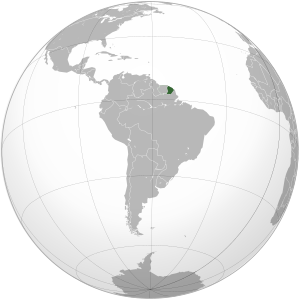
French Guiana was first settled by the French in 1604. However, early settlements were abandoned because of conflicts with the local people and tropical diseases. The settlement of Cayenne was established in 1643 but was later abandoned and then re-established in the 1660s. Except for short times when the English, Dutch, and Portuguese took control, Guiana has remained under French rule ever since. From 1851 to 1951, it was the site of a famous prison island called Devil's Island. Since 1946, French Guiana has been an overseas department of France.
In 1860, a French adventurer named Orelie-Antoine de Tounens declared himself king of a region in South America. His claim was not accepted by other countries, and Chile and Argentina took firm control of the areas he claimed.
Images for kids
-
Portrait of Jacques Cartier by Théophile Hamel, arr. 1844
See also
 In Spanish: Colonización francesa de América para niños
In Spanish: Colonización francesa de América para niños


